Case Studies
Immediate Loading of Single Free Standing Implant : A Realistic Options for Our Patient?
Dr Firdaus Hanapiah
BDS(Otago) MSc(Lon.) FDSRCS(Eng.)
Dr Divakaran Nair
BDS, FICD, FADI, FICCDE
Introduction
When Professor Branemark introduced the modern implant in the late 1960's as we know them today, he applied a set of rules for his disciples to follow to ensure that the outcome of their treatment is a successful one.(1)
One of the principles that he stipulated was to leave the implants in the jaws fully covered by mucosa and free of occlusal loading. This was, rightly so, to ensure that osseointegration occurred in a gradual manner, free from excessive occlusal load as well as bacterial attack from the oral mucosa.
However in the late twentieth century it was observed that if several implants were linked together, it was possible to place a denture or a temporary bridge linking these implants and immediate function was possible. This means that it was not a necessity to wait for osseointegration to occur before oral function can be restored for these patients. It was also found that there was no loss of both quality and quantity of osseointegration if these implants were subjected to appropriate loading (2).
Recently the envelope was pushed even further by introducing the concept of immediate loading for single implants. This concept is not new as it is practiced by a minority of dentists in the fringe of implantological fraternity for many years. However, the mainstream implantologists with scientific evidence, have finally looked at it in a more empirical way.(3)
The Conventional Method of Implant Treatment Modality
The conventional way of placing an implant was to place an implant at appropriate bed of mucosa and bone. Care is taken in the treatment planning such as taking appropriate radiograph and models. However it must be pointed out that an OPG view will only show the vertical length of the alveolus but not the thickness of bone in this area. Therefore a simple sharp calliper comes in handy in the clinical examination in determining the thickness of the mucosa. To be more comprehensive, one may chose to use CT scan as a routine armamentarium, although the cost may be prohibitive for some patients. Single anterior teeth are probably the most technical implant to do as they may integrate but still be an aesthetic failure. The depth of placement for these anterior implants must also be considered as mucosa in this area may be very thin. Therefore final placement of the implant is advised to be at least 2 mm subcrestal. (Fig.1)
Once the implants are placed, they should be totally covered by the mucosa and left for at least four months for the maxilla and a month less for the mandible. A second stage procedure is then done to develop the scalloping effect the gingival margin and the development of the papillae. The impression is taken and crown is constructed. It is then inserted and occlusion adjusted. If position of the implant and crown constructed correctly, a successful and aesthetically pleasing result will ensue.
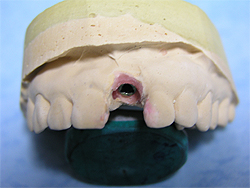
Fig1- Demonstrate the ideal depth of a single implant placed in an anterior region which should be around 2mm below the crest of bone.
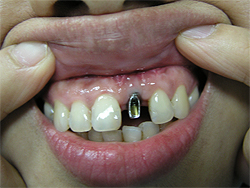
Fig 2 - Insertion of the abutment after 2 weeks post second stage exposure.
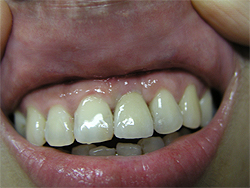
Fig 3 - The implant crown after 2 weeks post insertion, note the well developed papillae
The Immediate Loading of Single Implants
The need for such treatment is obviously due to patient driven needs for quicker and simpler treatment and shorter treatment turn-around for the practitioner.
The development of newer system of single stage solid state implant such as the Nobel Direct (Yorba Linda, Ca.) and Q implant (Karlsruhe, Germany) have made immediate implantation more common in the daily dental practice.
The advantages of such systems are several, which will be discussed, as well as the drawbacks and their relative contraindications.
The Solid state implants are ideal for immediate loading as a temporary crown can be built directly on its standing abutment. There is also no "gaps" between the abutment from that of the fixture since they are one unit. This will then end the controversies surrounding micro-leakage factor that may be contributing to bone loss and subsequent mucosal recessions. The implants are stronger, especially in the narrower diameter as they are made as a solid state instead of a hollow screw. There is also no abutment screw for retention that may be prone to breakage.
The immediate loading may also be ideal for patients as it gives them an immediate result. They leave the dental practice with teeth that is aesthetically acceptable. No longer will they have to deal with dentures and messy relining.
Case Report of an immediately loaded multiple implants
A 45 year old man came to the dental practice requesting replacement of several teeth of the right maxilla. He is a very busy executive who is intolerant of dentures. Therefore it was decided that a Nobel Direct (Yorba Linda, Ca.) implants are to be placed in the right maxilla. A flapless method was employed thus eliminating cutting of the periosteum thus less post operative pain and elimination of any scaring. Three Implants were placed and a temporary crown were inserted into the abutments as demonstrated below
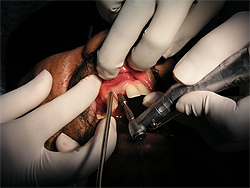
Fig 4 - A mucosal trephine is used to expose the bone.
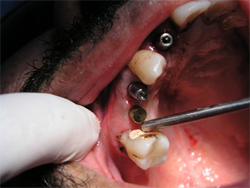
Fig 5 - A guide pin in place to determine a correct orientation. Note also the largely bloodless surgical field.
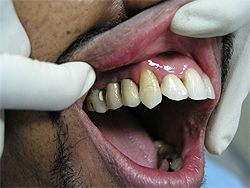
Fig 6 - Two weeks post-operative view, provisional composite crowns, note Implants are 12,14,15. Also note the scarless operative site.
The Immediate Loading of Single Implants
Immediate implantation is the next step in the ever advancing field of implantology. We can envisage one day, all patients will walk out of our practice on immediately loaded implants, with Dorris Day smile!
However we warn that not all patients are suitable for immediate implantation as the risk of complications is always higher than the conventional method. Care must be taken that there is adequate bone quality and quantity. We recommend that a CT scan and specialised software such as Simplant, 3D planning software (Materialise, Leuven, Belgium) be used in treatment planning.
Immediate loading of a single standing implant is highly recommended for the suitable candidate when all the right precautions have been taken to ensure a successful outcome of the case, as demonstrated above. The analogy would be a sure win situation as taking a penalty kick in football with no goalkeeper to defend the goal line!
References
1. Long-term follow-up study of osseointegrated implants in the treatment of totally edentulous jaws. R Adell, B Eriksson, U Lekholm, PI Branemark, T ... - Int J Oral Maxillofac Implants, 1990 - Winter;5(4):347-59.
2.Immediate Loading of Implants in Partially and Fully Edentulous Jaws: A Series of 27 Case Reports. Robert A. Jaffin , Akshay Kumar ,Charles L. Berman Journal of Periodontology,May 2000, Vol. 71, No. 5, Pages 833-838
3. Immediate loading of single-tooth implants in the anterior maxilla. Preliminary results after one year Martin Lorenzoni, Christof Pertl, Kehao Zhang, Gernot Wimmer, Walther A. Wegscheider. Clinical Oral Implants Research 14 (2), 180-187.